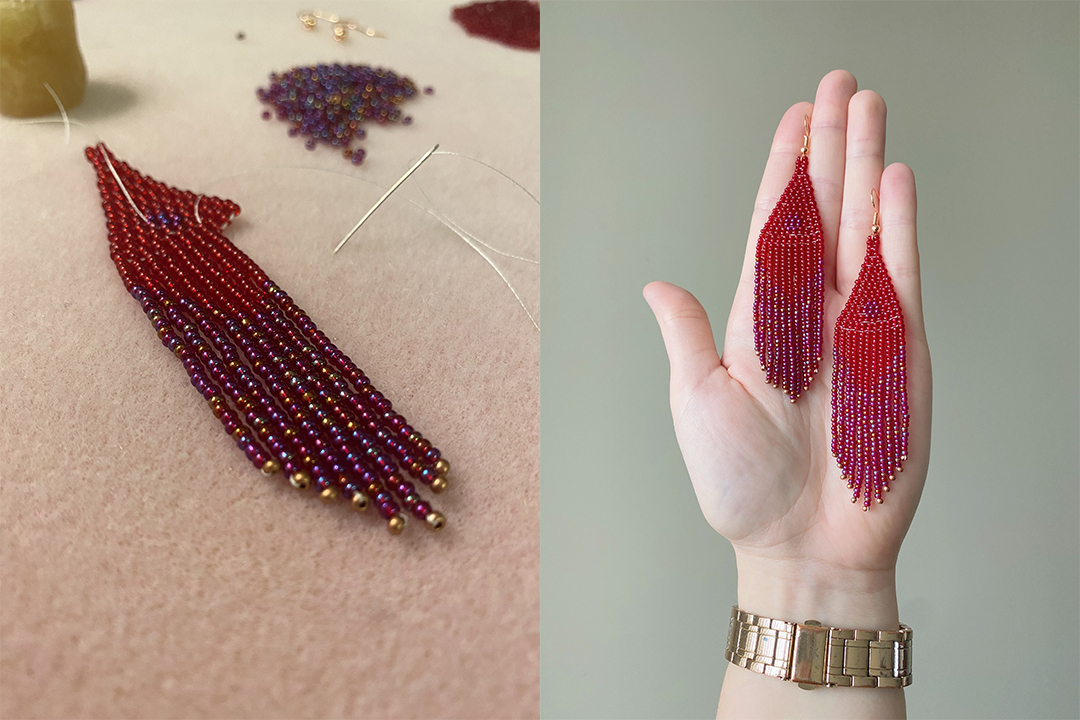Changing seasons, Vancouver sunsets, and California beaches are all among Julia Hutlet’s sources of inspiration for her beaded earrings.
I first met Hutlet when we were both delegates at Equal Voice’s 2021 Daughters of the Vote (DOTV) program, which I later reviewed. I was struck by how passionately she spoke of Indigenous issues and how beautiful her beaded creations were. After interviewing Hutlet for the DOTV piece, I wanted to highlight her incredible creations, and she was kind enough to agree to a written interview with me.
“When I learned how to bead… I really felt like I belonged to the [Métis] community and was not just someone claiming an identity because it was in my genetics,” Hutlet wrote to The Varsity.
For the Métis people, beading is a significant cultural practice. According to Hutlet, Métis beadwork is a meld of First Nations beading and European embroidery.
The art of beading
Hutlet first learned to bead through her employment at Riel House, a national historic site that used to be home to Louis Riel’s mother. The site pays homage to Riel, who was executed for leading the Métis people in the Northwest Resistance against the Canadian government, which was encroaching on their way of life. Located in Hutlet’s hometown of Winnipeg, Riel House allows visitors to learn about and experience Métis culture.
Initially learning on flat felt, Hutlet began learning how to bead with the two-needle method, taught by Louise Gordey and Janelle Poiron, before moving to the one-needle method, taught by Teresa Byrne. In the two-needle method, two needles and two pieces of thread are used simultaneously. One needle is used to string the beads while the other is used to tack down each individual bead.
The one-needle method is similar, but uses only one needle — as the name would suggest. Hutlet favours the one-needle method because she beads in small increments.
After perfecting her craft on flat felt, Hutlet taught herself to bead earrings, which she now makes and sells while attending law school at the University of British Columbia.
Making a typical pair of earrings is an involved process, taking anywhere between two to four hours to complete. Hutlet begins with a brick stitch, creating a triangle on which the finding — the hook part you put in your ear — will hang. Hutlet reinforces the stitch before starting on the fringe, counting beads, and matching their sizes.
She threads through the brick stitch, carefully maintaining the right tension to ensure that the earrings will sway but still look polished, with the string hidden. Next, to ensure that the earrings are secure, Hutlet burns the string after weaving it through the brick stitch. Then, she attaches the findings with pliers.
Connection, medicine, joy
Although creating the earrings is a physical process, it is also inseparably tied to Hutlet’s culture and identity as a Métis woman.
“Métis women would ‘decorate’ their men in beadwork vests, hats, gauntlets… so that when the men went to trade with First Nations or European settlers, they looked very wealthy and important,” Hutlet wrote.
Some particular designs are also symbolically linked to the Métis, who are known as the “flower beadwork people.” Métis beaded flowers always have an odd number of petals and one vine connecting all of the flowers. The vine was traditionally white, but it is now green in much of modern Métis beadworking.
Hutlet considers beading to be a form of medicine. “With earrings, you are able to carry that medicine with you everywhere you go,” Hutlet wrote.
Bringing joy to people who wear her creations is one of Hutlet’s main motivations for selling and giving away what she beads. Moreover, Hutlet enjoys beading and only does so when she is in a positive frame of mind to ensure that her creations never hold bad energy.
Beading Métis identity, community
As beading is a cultural practice, in Hutlet’s view, it would be cultural appropriation for settler Canadians to use Indigeneity to sell products or to profit off of Indigenous beading methods. It is, however, encouraged to support Indigenous artists like Hutlet by purchasing and wearing their creations.
For Hutlet, beading is particularly important to her identity as a Métis woman. Hutlet didn’t know that she was Métis until she was nearly an adult, which is a common story for many Métis people whose families could often pass as white and chose to do so in the face of colonialism and racism.
As Hutlet wrote, “nobody tells you how to begin” when you find out that you are Métis. Finding out that you are Indigenous when you thought you were white is a shock. Hutlet was accused of seeking attention when trying to discover her Indigenous culture and heritage.
It wasn’t until she started university that Hutlet felt comfortable fully exploring her Indigeneity, and it was a summer job at the Riel House that led her to beading. Beadwork made Hutlet feel truly connected to her community, partly because of its significance to the Métis people, and partly because Riel House was a supportive environment in which Hutlet met close Métis friends. Hutlet craved cultural support, and she found it through beading.
If you would like to support Hutlet’s beading, you can find her work on Instagram, @beadworkbyjulia.


